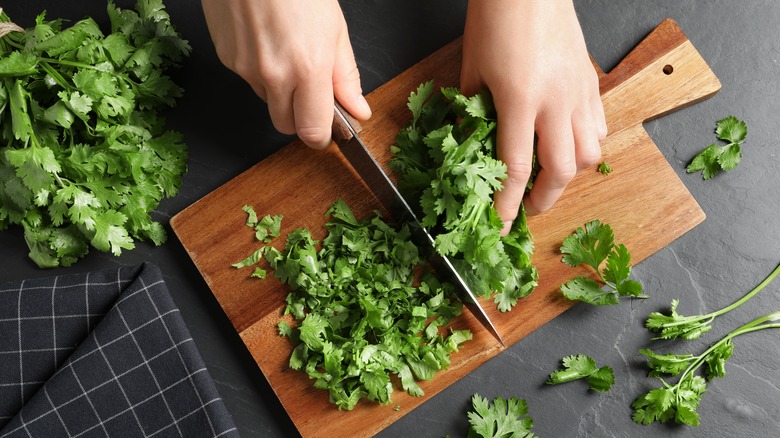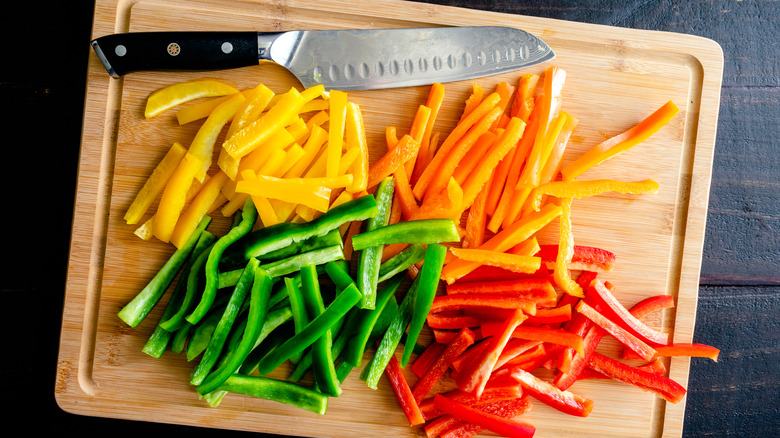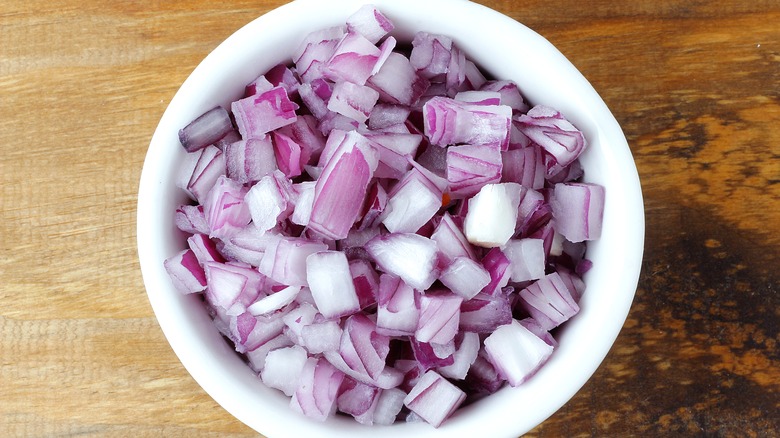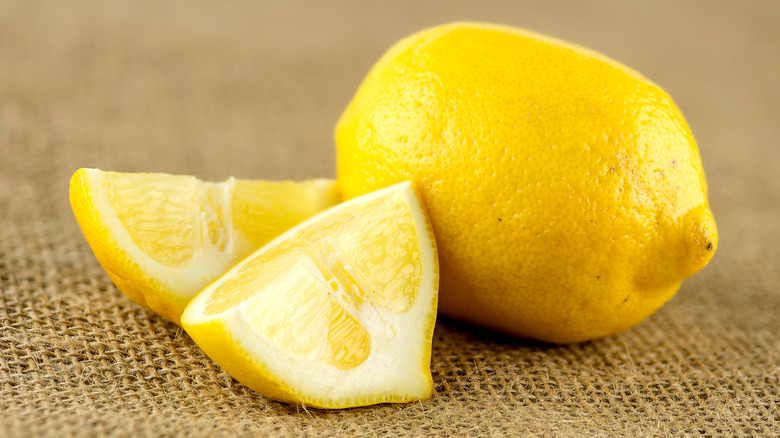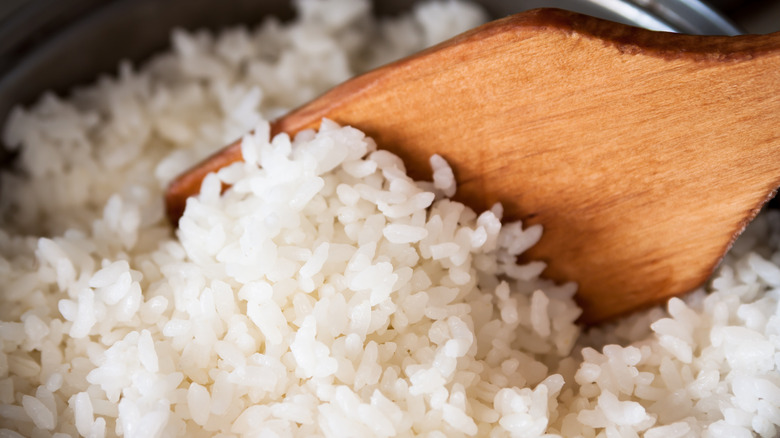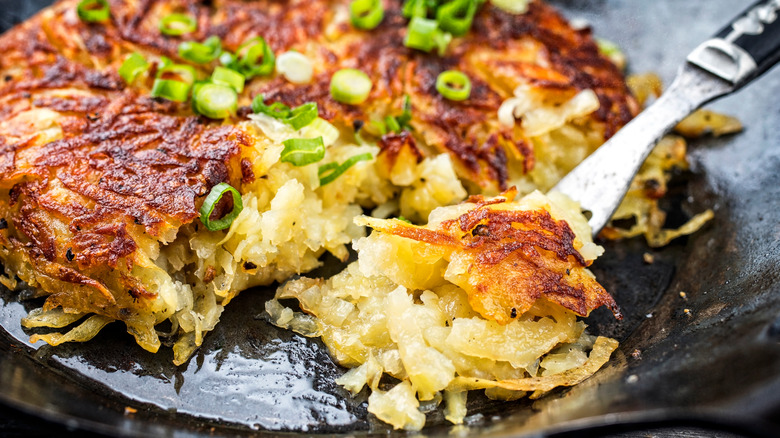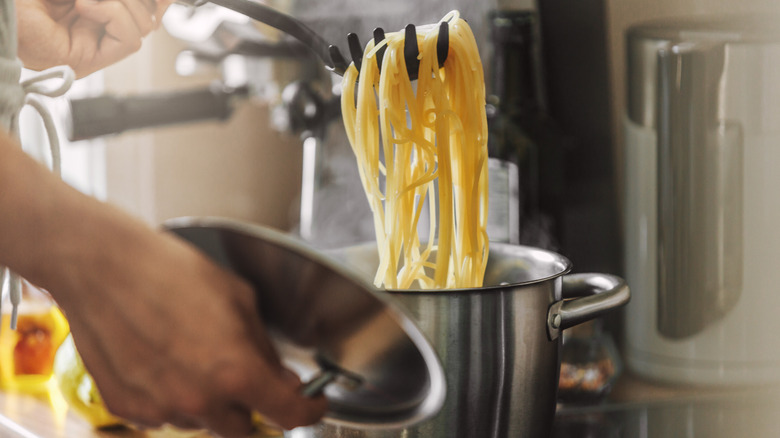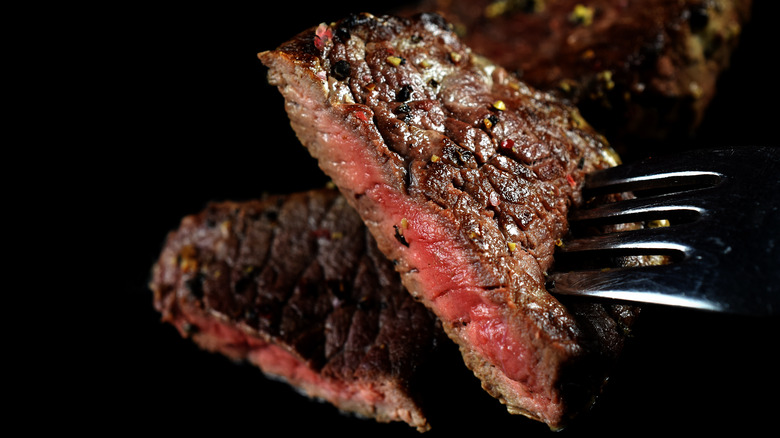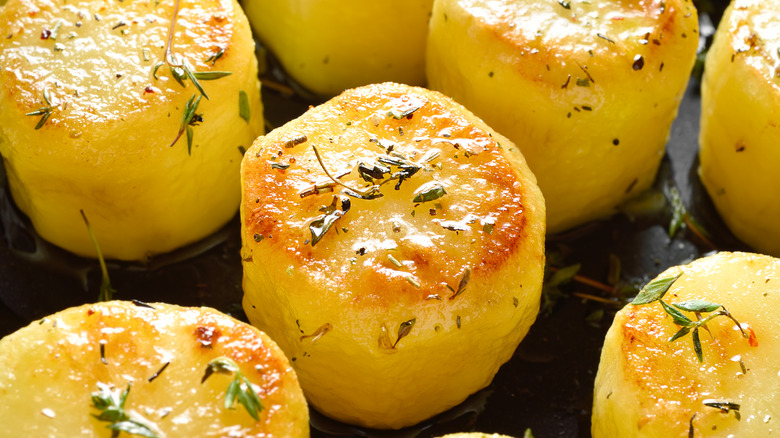Gordon Ramsay's 11 Best Tips For Home Chefs
One of the joys of cooking is that there's no shortage of interesting things to learn. From generational secrets to unique hacks that will impress grandma, stumbling upon the right tip can flip your kitchen upside down. Let's be honest, most of us may never become professional chefs, but we'll still try a pancake toss. That's why it's no surprise that the majority of home cooks believe they have the skills to compete against a celebrity chef.
Likely to give many home cooks a run for their money is seven-time Michelin star holder Gordon Ramsay, one of the foremost celebrity chefs in the world. A simple word to describe his career is impressive, spanning three decades across various facets of the food industry: head chef, restaurateur, and TV star. Beyond his larger-than-life personality and reputation for precision cuisine, a quality that's always stood out about Ramsay is his love for teaching.
As a source of inspiration for home cooks around the world, he can show you how to use your trusty knife to slice through the thickets of the culinary unknown. Whether hoping to wow at your next dinner party or to make your kid enviable school lunches, these are some of Gordon Ramsay's best tips to add to your cooking toolbox.
Preserve chopped herbs with this cutting technique
On your culinary road trip, losing the natural taste of chopped herbs is like running out of gas on the way to flavor town. Essential to presentation, aroma, and flavor, fresh herbs add to the experience, helping bring recipes to life. They're also an affordably healthy addition to your weekly grocery list and easy to grow at home if you have a green thumb.
In order for your meal to benefit from fresh herbs, they need to remain fresh and flavorful. According to Gordon Ramsay, herbs require a delicate touch. When too much pressure is applied, whether from your hands or knife cutting technique, the juices inside seep out and stain the cutting board. Ramsay recommends the "three-finger rule" to preserve flavor and avoid staining.
For this technique, place your middle finger in front with your index and ring fingers behind. Your fingers should form a shape similar to a triangle. This will help guide your knife as you chop herbs and protect you from being cut. Using chives to demonstrate in a YouTube video, Ramsay begins by stacking them into an even bunch. He then removes the tail ends for disposal. Placing his fingers in position, he adds a soft pinch to the chive bunch. It's important to "let the knife do the cutting" by keeping the base of the blade on the cutting board as you chop. Following these steps will give you finely prepared cylinder-shaped chives.
Quickly ripen fruit using bananas
Finding perfectly ripe fruit can sometimes be an exercise in "fruitility." It really takes an understanding of when certain fruits are in season and also how to spot varying degrees of ripeness. With that said, even master fruit pickers fall victim to the unpredictable whims of their local grocery store supply.
Fruit ripening is a natural process that's caused by a gaseous plant hormone called ethylene. A study shared on Science Daily found that as fruit ripens, its health benefits increase, producing "highly active antioxidants." Along with providing protection against heart disease, ripe fruit is brighter and more aromatic and flavorful.
Unfortunately, there will always be times when you simply have no choice but to purchase unripe fruit. In preparation for whatever awaits you in the produce section, Ramsay has a quick and easy tip. Sweeten the deal faster by storing your unripe fruit inside a paper bag alongside a banana (via YouTube). Bananas happen to produce ethylene, the previously mentioned gas that causes ripening.
Cut perfect bell peppers upside down
Bell peppers not only add dynamic flavor to your meal but also a pleasing and colorful aesthetic. To top it off, they're rich in vitamin C and antioxidants and pack a decent amount of fiber (via Healthline). Despite so many benefits, using the wrong cutting technique on these flavorful seed bombs can result in a large mess and unnecessary food waste.
Ramsay's first tip for cutting bell peppers is learning to identify perfect ones. When choosing, smooth and firm are the tell-tale signs. A stable positioning is essential to cut produce correctly, so the first step is to remove the stalk and flip the bell pepper upside down. It will create a flat side for safer, more accurate cutting. The next step is to slice from the top down, continuing around each side. As you cut, you'll notice the insides remain intact, saving you from cleaning the seeds up.
With each slice, place the skin-side down on the cutting board and flatten both ends with your fingers in a claw-like fashion. You then cut the bell peppers into strips, or as the French say, julienne style. Per Ramsay's YouTube, rinse and repeat the same to each bell pepper slice until you have perfectly cut seedless strips.
Never remove the onion root when cutting
Many tears have been shed to enjoy this common recipe staple. Ironically, the reason behind an onion's tear-inducing vapor is the same we have for crying: It's a defense mechanism. In addition to stained cheeks, the simple act of cutting an onion can be a bit of a challenge, too. So, to avoid the pungent waterworks and get evenly diced pieces, Ramsay suggests following these steps.
First and probably most important of all: Don't cut off the onion's root. When you remove it, onion juices bleed and cause tears. Slice the onion in half through the root by making one long incision in the center, then allow the weight of the knife to handle the rest of the work. As with bell peppers, place it cut-side down and secure it with a claw grip. Pointing towards the root, begin slicing down from one side to the next without removing it. Notice how the root holds the onion together as you go.
Per Ramsay's YouTube channel, the next steps are best for small, evenly diced pieces. With the root facing you, make an incision from a right angle to the previous slices. The goal is to quarter the half onion, cutting in your direction at a slight downward angle until you reach the middle. Repeat the same step near the top of the onion, maintaining the claw grip to hold it in place. These two cuts help prepare the onion for even crisscross dicing.
Combine lemon juice and water to keep produce fresh
Although avocados, potatoes, and apples are three totally distinct types of produce, they share one thing in common: They tend to turn brown after being cut and exposed to oxygen. Not only do brown marks make produce less attractive (via Institute of Food Science & Technology), but it's also an indication that they're losing freshness and nutrient content. To maintain its vibrant aesthetic, Ramsay offers a simple solution.
According to Ramsay, the ultimate trick to keep fruits and veggies from browning is to store cut produce inside a covered bowl of lemon juice and water. There are two factors that grant lemons anti-browning powers: Their pH level and naturally occurring ascorbic acid, also known as vitamin C. As Ramsay explains, its acidity levels prevent a chemical reaction between oxygen and the enzymes found in produce (via YouTube).
This preservative solution can be made by squeezing ½ a cup of natural lemon juice into 2 quarts of water. Bottled lemon juice will do the trick as well.
Infuse your rice with seasoning while it cooks
There's something about a pot of perfectly cooked rice that fills you with a sense of pride. That moment when you remove the lid and steam escapes revealing the ideal consistency. In truth, perfect rice can be elusive. Even as adults, many of us fall victim to its deceptively easy cooking instructions. The irony is that rice is as easy to mess up as it is to make perfect.
Ramsay offers a unique tip for cooking beautiful-looking rice. Start by measuring 14 ounces of rice into a bowl, then use a strainer to rinse out dust and starch. Rinsing prevents clumping in the pan and gives the rice a fluffy finish. Once rinsed and into a pot, a hack to enhance plain-tasting rice is to infuse its cooking process with seasoning. Ramsay then adds three pierced cardamom pods, two star anise, salt, and pepper (via YouTube).
Next, fill the pot with one part of rice to 1 ½ parts of cold water. Cover your pot with a lid and bring the water to a boil as quickly as possible. After, turn it down to a simmer and let it sit for 8 to 10 minutes. Whatever you do, never remove the lid. Let it steam and absorb all of the infused water. Following the suggested cook time, remove the lid, cardamom pods, and star anise. Use a fork to fluff through, allowing it to breathe for a final lightness.
Add butter to make perfect fried eggs
Fried and egg are two words that should always be used in the same sentence. Great on their own or paired with everything from your favorite meats, seafood, and salads, these protein phenoms are the real deal. Along with being deliciously complementary, they're pretty quick and easy to make. To get your morning going — or any part of your day for that matter — Ramsay shares a trick for perfect fried eggs.
Based on Ramsay's TikTok, prepare your pan with a dab of hot oil, then use a flat surface to crack two eggs into it. The yolks should turn a vivid yellow as they slowly cook. Lightly season the eggs with salt and chili pepper before adding a few small pieces of butter to the pan. In a short moment, the butter will begin to froth, cooking the top of your eggs and giving them a satisfying fry.
Grate your potatoes for restaurant-quality hash browns
Some restaurant breakfast staples are darn hard to replicate at home. Hash browns sit on that list. The ingredients seem simple enough: Finely chopped potatoes and lots of oil. But somehow, cooking at home can often lead to soggy results. Is it the potato or the type of oil you use? To teach you the savory science behind making restaurant-quality hash browns, Ramsay offers these tips.
The first step to fantastically flavorful hash browns is peeling your potatoes. Peeled potatoes hold better and are easier to grate, which is suggested over cutting. Combine grated onion with your potatoes to give your hash browns extra taste and crispiness. Move the freshly grated bits to a strainer and season them with salt, pepper, olive oil, and cayenne. Using your hands, blend the mixture while squeezing out excess water. The more liquid you remove, the crispier the hash browns will turn out (via YouTube).
Pour the mixture into a large pan of hot olive oil to seal it together as it cooks. Slipping slices of butter around the edges of the pan will help it caramelize. With the bottom cooked to a buttery crisp, use a plate to flip the hash browns by placing it over the pan and turning it upside down. From there, simply slide it off the plate and back into the pot. Before you know it, in mere minutes, you'll have the perfect hash browns.
Pour olive oil into your pasta water
The debate for what constitutes the best way to conjure a magical bowl of perfect pasta continues. Salty water seems commonly accepted, yet the amount of salt is subject to opinion. Temperature is also considered an important determining factor, as some believe you should start with cold water. In the face of capellini critics, Ramsay's approach to perfect pasta involves an ingredient that's uncommon amongst most professional chefs.
He begins as expected, filling his pot with water and a healthy sprinkling of salt. Then with casual confidence, he pours olive oil into the pot. While likely to offend pasta purists, in a YouTube video, it appears Ramsay steadfastly believes olive oil keeps the noodles from sticking together. And he's right, as the same applies to rice. Despite that fact, it's generally accepted that adding oil is bad because it prevents sauce from sticking to the noodles.
Continuing his fearless pursuit of the perfect pasta, Ramsay brings the water to a rolling boil, which makes the noodles roll around. Angel hair is used for the demonstration and melts immediately as it's placed into the boiling water. Using tongs, he takes the exposed angel hair and twists it around into the pot of water. Rather quickly, he has nicely cooked, slightly firm, al dente pasta. Now it's time to drain it using a colander, add a dash of salt and pepper, then finish with a tablespoon of olive oil.
Sear the perfect steak with this ultimate tip
The alluring aroma of a juicy rib-eye that's well-seasoned and seared to succulence will make you float across the room. According to a survey by independent meat purveyor and supplier Linz Heritage Angus, out of 1,084 U.S. consumers, 70% consider steak their favorite food. Whether rare, well-done, or anywhere in between, no matter your preference, cooking the perfect steak isn't easy.
Thankfully, master chef Gordon Ramsay offers the ultimate tip to unlocking steak perfection. For his multi-pronged approach, the first step is resting the steak at room temperature for at least 10 minutes. It helps you avoid tense and potentially undercooked meat. Once rested, heavily season your steak, rolling it in salt and black pepper once, then adding another round before beginning to cook. When ready for the pan, make sure to place it away from you to prevent burns from splashing oil.
"It's all about the sear," Ramsay shares on his YouTube channel. The key to great searing is color; it lets you know it's flavorful and ready to be flipped over. Next, introduce fragrance by adding an aromatic combination of garlic, thyme, and rosemary. Build on the flavor profile with cubes of butter and baste the melted mixture atop the steak until it caramelizes. After cooking, let it rest to help retain maximum juiciness. When it's ready to serve, make sure the pieces you cut are at least half a centimeter thick.
Use chicken stock for fondant potatoes
French cuisine is known for its emphasis on precision, using fresh ingredients, and artful presentation. It also serves as the foundation of Ramsay's cooking style. With an endless list of recipes to choose from, if you're looking to elevate your home cooking to haute cuisine, he's surely an encyclopedia full of elegant eats.
Affordable and versatile, potatoes are widely used in French cuisine and fancily dubbed "pommes de terre." A classic restaurant dish that features the popular root vegetable is fondant potatoes. While its recipe is quite basic, the aesthetic makes it a suitable addition to any fine dining experience. It's also great for gatherings at home when you want to impress guests with a gourmet side. The next time it's your turn to host a dinner party, follow these steps for Ramsay's superb fondant potatoes.
According to Ramsay's YouTube instructions, begin by preheating your oven to 392 F. Make sure the potatoes you choose are hardy and can withstand the cooking process; he recommends Desirée potatoes. Peel the potatoes, cut them into halves, then sprinkle a nice coating of seasoning. Using a roasting tray, cover the bottom with oil, then add the potatoes cut side down. Cook until they color, combining thyme and butter for a fragrant flavor. Flip them over and add chicken stock until it reaches just below the potato. Once the stock reaches a boil, place the tray inside the oven for several minutes for added crispiness.

